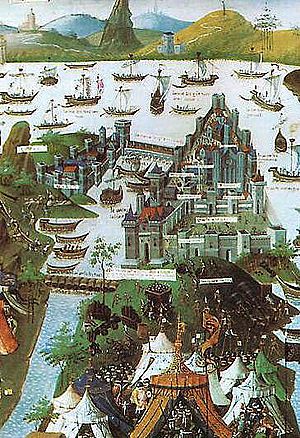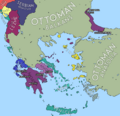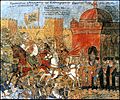Fall of Constantinople facts for kids
The Fall of Constantinople was a really big event in history! It happened on May 29, 1453, when the Ottoman Empire took over Constantinople. This city was the capital of the Byzantine Empire. The Ottoman army was led by their young Sultan, Mehmed II, who was only 21 years old. They defeated the Byzantine Emperor, Constantine XI Palaiologos. This important conquest happened after a long 53-day siege that started on April 6, 1453.
This event marked the end of the Byzantine Empire. It also meant the end of the Roman Empire, which had lasted for almost 1,500 years! Before this, Ottoman Sultans had already taken most of the Byzantine lands over many centuries. A few places, like the Morea Despotate and the Empire of Trebizond, were taken by the Ottomans a few years later.
The fall of Constantinople had huge effects. The Ottoman Turks now controlled the Balkans. This meant nothing could stop them from expanding further into Europe. Their expansion continued until after the Battle of Vienna in 1683. After Constantinople fell, many people escaped to Western Europe. These refugees, especially Greek scholars, helped start a new way of thinking called humanism. Their arrival in Italy is even said to have helped kick off the Renaissance.
Contents
The Fall of Constantinople: A Major Event
The Fall of Constantinople was a turning point in history. It ended an empire that had lasted for ages. It also opened new doors for the Ottoman Empire.
Who Was Involved in the Siege?
The main people involved were the Ottomans and the Byzantines.
- The Ottomans: Their army was led by Mehmed II. He was a very determined and clever young leader. He wanted to make Constantinople the new capital of his empire.
- The Byzantines: They were led by Emperor Constantine XI Palaiologos. He fought bravely to defend his city. However, his army was much smaller than the Ottoman forces.
Why Was Constantinople So Important?
Constantinople was a very special city.
- Location: It was located in a perfect spot. It controlled trade routes between Europe and Asia. It also sat between the Mediterranean and Black Seas.
- History: It was the capital of the Byzantine Empire. This empire was the eastern part of the old Roman Empire. It had a rich history and culture.
- Symbolism: For Christians, it was a very important religious center. It was home to grand churches like the Hagia Sophia.
How Did the Ottomans Win?
The Ottomans used several smart strategies to capture the city.
- Giant Cannons: They used huge cannons called bombards. These cannons could fire massive stone balls. They slowly broke down the strong Walls of Constantinople.
- Moving Ships Overland: The Byzantines had a big chain across the Golden Horn. This chain stopped enemy ships from entering the harbor. But Mehmed II had his ships moved overland on greased logs! This surprised the Byzantines.
- Overwhelming Numbers: The Ottoman army was much larger than the Byzantine defenders. They attacked the city from many sides.
The Final Attack
The final attack happened on May 29, 1453. Ottoman soldiers broke through the walls. Fierce fighting took place inside the city. Emperor Constantine XI fought until the very end. The city eventually fell to the Ottomans.
What Happened After the Fall?
The fall of Constantinople changed the world in many ways.
New Ottoman Capital
Constantinople became the new capital of the Ottoman Empire. It was renamed Istanbul. The Ottomans rebuilt the city and made it even grander. Many churches, including the Hagia Sophia, were turned into mosques.
Impact on Europe
- Trade Routes: The Ottomans now controlled important trade routes. This made European countries look for new sea routes to Asia. This led to the Age of Exploration.
- Spread of Knowledge: As mentioned, many Greek scholars fled to Western Europe. They brought ancient Greek texts and knowledge with them. This helped spark the Renaissance in Italy. It was a time of great learning and art.
- Fear of Expansion: European countries became worried about the growing power of the Ottoman Empire. This led to many conflicts over the next centuries.
Images for kids
-
The chain that closed off the entrance to the Golden Horn in 1453, now on display in the İstanbul Archaeology Museums.
-
The Dardanelles Gun, cast by Munir Ali in 1464, is similar to bombards used by the Ottoman besiegers of Constantinople in 1453 (British Royal Armouries collection).
-
Following the city's conquest, the Church of the Holy Wisdom (the Hagia Sophia) was converted into a mosque.
-
Sultan Mehmed II the Conqueror, by Gentile Bellini
-
Mehmed the Conqueror enters Constantinople, painting by Fausto Zonaro
See also
 In Spanish: Caída de Constantinopla para niños
In Spanish: Caída de Constantinopla para niños















